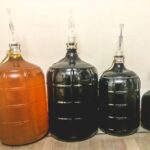Wine Making
Moscato wine, also known as Muscat, is a sweet wine made from the Muscat grape variety. It is a popular choice among wine enthusiasts due to its sweet flavor and low alcohol content. Moscato wine is produced using different techniques depending on the desired outcome, but the general process involves harvesting the grapes, crushing them, and fermenting the juice. Here is a breakdown of the steps involved in making Moscato wine:
Grape Harvesting: The first step in Moscato wine making is to harvest the Muscat grapes at the right time, when they have reached their peak ripeness. The grapes are usually harvested by hand to ensure that only the best quality grapes are used.
Crushing: The grapes are then crushed to extract the juice, which will be used to make the wine. Some winemakers may opt to leave some of the grape skins in contact with the juice during the crushing process to add a slight color and flavor to the wine.
Fermentation: After the juice is extracted, it is placed in a stainless steel tank or oak barrel to begin the fermentation process. During fermentation, yeast is added to the juice to convert the natural sugars in the grapes into alcohol. The fermentation process typically lasts between two to four weeks.
Aging: After fermentation, the wine is aged in stainless steel tanks or oak barrels for several months to develop its flavor and aroma. Some Moscato wines are aged for a shorter period to retain their freshness and fruity flavor.
Blending: Once the aging process is complete, the wine is blended to achieve a consistent flavor and aroma. Moscato wines are usually blended with other grape varieties, such as Chardonnay or Pinot Grigio, to create a unique taste.
Bottling: Finally, the Moscato wine is bottled and labeled for distribution. Some winemakers may add a slight amount of carbon dioxide to create a slight fizz or bubbles in the wine, which is known as Moscato d’Asti.
In conclusion, Moscato wine making is a complex and delicate process that requires careful attention to detail to achieve a high-quality product. From grape harvesting to fermentation, blending, and bottling, each step plays a crucial role in determining the final flavor and aroma of the wine. Whether you prefer a sweet, fruity Moscato or a more complex, aged version, there is a Moscato wine out there to suit your taste.









